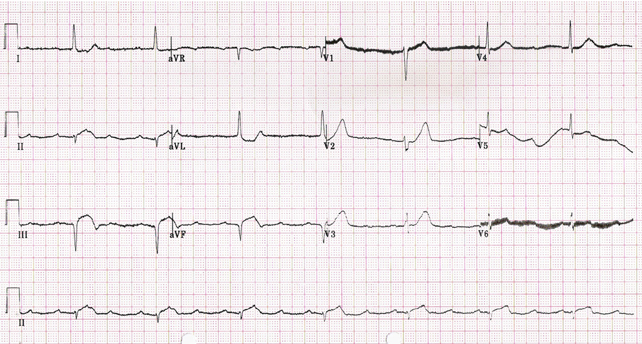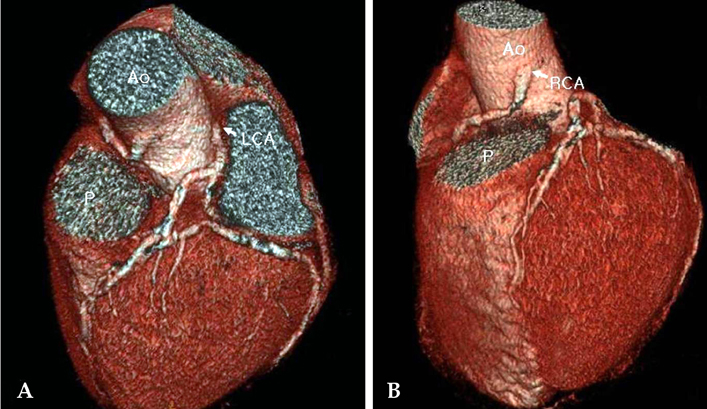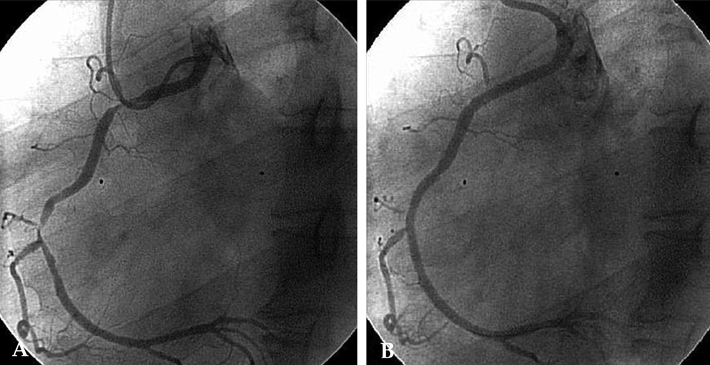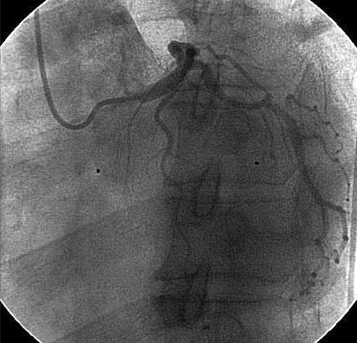Yonsei Med J.
2009 Feb;50(1):164-168. 10.3349/ymj.2009.50.1.164.
A Case of Acute Myocardial Infarction with the Anomalous Origin of the Right Coronary Artery from the Ascending Aorta above the Left Sinus of Valsalva and Left Coronary Artery from the Posterior Sinus of Valsalva
- Affiliations
-
- 1Department of Cardiology, Inha University College of Medicine, Incheon, Korea. kdhmd@korea.com
- 2Department of Radiology, Inha University College of Medicine, Incheon, Korea.
- KMID: 1782985
- DOI: http://doi.org/10.3349/ymj.2009.50.1.164
Abstract
- Coronary anomalies are rare angiographic findings. Moreover, there are few reports of cases of an anomalous origin of the right coronary artery from the left sinus of Valsalva and of the left coronary artery from the posterior sinus of Valsalva. Here, we report a case with an anomalous origin of the right coronary artery from the ascending aorta above the left sinus of Valsalva and the left coronary artery from the posterior sinus of Valsalva. This was observed in a patient who was treated for a myocardial infarction of the inferior wall caused by a thrombus in the proximal right coronary artery. The patient was treated successfully with the implantation of a stent in the anomalous origin of the right coronary artery using a 6Fr Amplatz left 1 catheter.
MeSH Terms
Figure
Reference
-
1. Angelini P. Coronary artery anomalies--current clinical issues: definitions, classification, incidence, clinical relevance, and treatment guidelines. Tex Heart Inst J. 2002. 29:271–278.2. Hutchins GM, Miner MM, Boitnott JK. Vessel caliber and branch-angle of human coronary artery branch-points. Circ Res. 1976. 38:572–576.
Article3. Liu LB, Richardson T, Taylor CB. Atherosclerotic occlusions in anomalous left circumflex coronary arteries. A report of 2 unusual cases and a review of pertinent literature. Paroi Arterielle. 1975. 3:55–59.4. Yip HK, Chen MC, Wu CJ, Yeh KH, Fu M, Hang CL, et al. Primary angioplasty in acute inferior myocardial infarction with anomalous-origin right coronary arteries as infarct-related arteries: focus on anatomic and clinical features, outcomes, selection of guiding catheters and management. J Invasive Cardiol. 2001. 13:290–297.5. El-Menyar AA, Das KM, Al-Suwaidi J. Anomalous origin of the three coronary arteries from the right aortic sinus Valsalva: role of MDCT coronary angiography. Int J Cardiovasc Imaging. 2006. 22:723–729.6. Fineschi M, Del Sordo M, Leosco D, Casini S, Bravi A. A rare anatomic variation of the anomalous origin of all three major coronary arteries from the right sinus of Valsalva. G Ital Cardiol. 1998. 28:564–566.
- Full Text Links
- Actions
-
Cited
- CITED
-
- Close
- Share
- Similar articles
-
- Sudden Death Associated with Anomalous Left Coronary Artery Origin from Right Sinus of Valsalva with Posterior Course
- Anomalous Origin of the Left Coronary Artery from the Right Sinus of Valsalva, which Presented as Acute Myocardial Infarction
- Anomalous Origin of the Left Circumflex Coronary Artery: A Report of 2 Cases and Echocardiographic Features
- Unroofing Procedure in the Treatment of Anomalous Origin of Right Coronary Artery from Left Sinus of Valsalva between Aorta and Pulmonary Trunk
- Acute Inferior Wall Myocardial Infarction as a Result of Anomalous Origin of the Right Coronary Arteryl from the Left Simus of Valsalva





